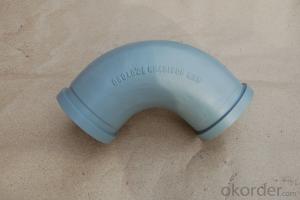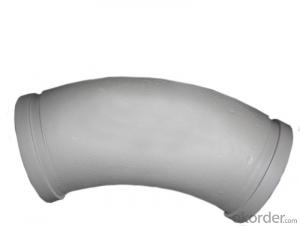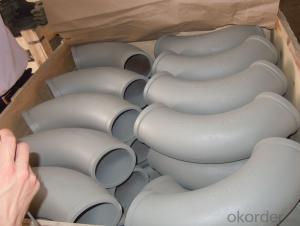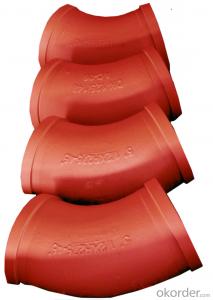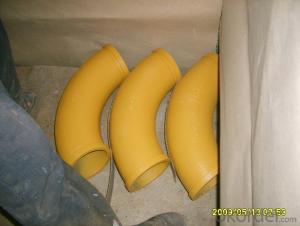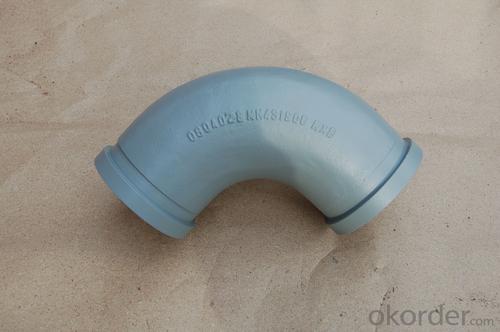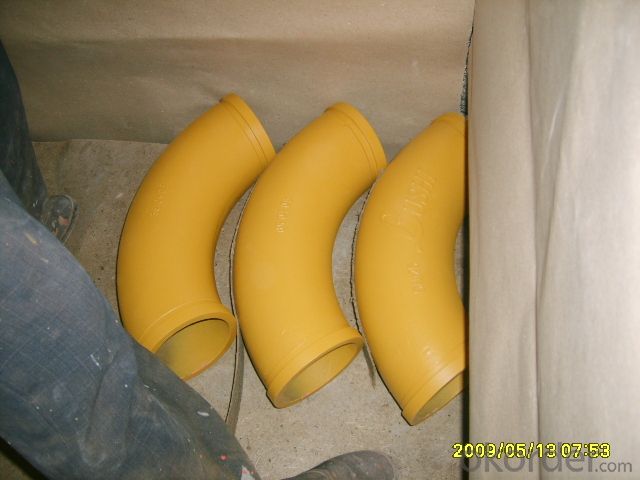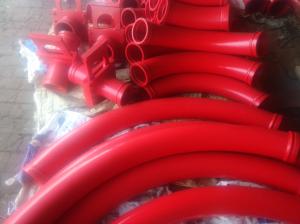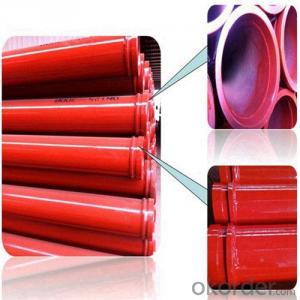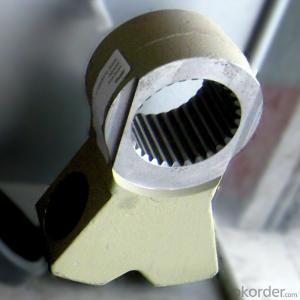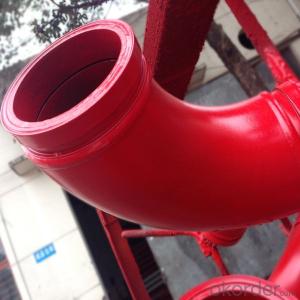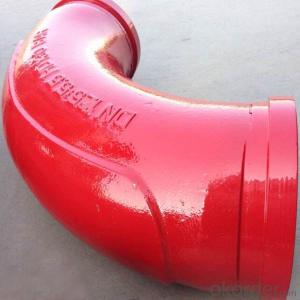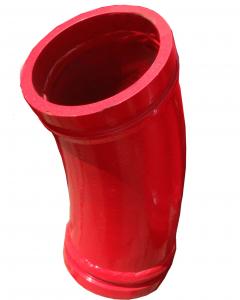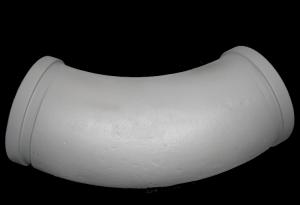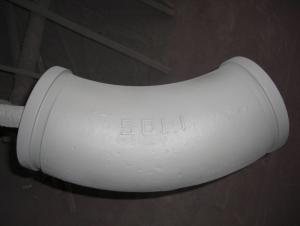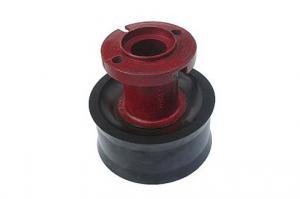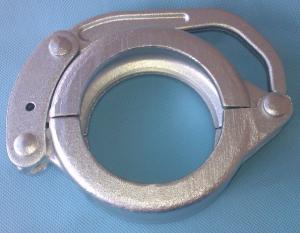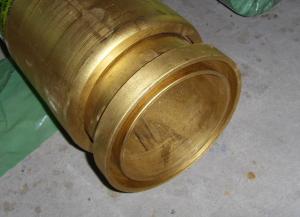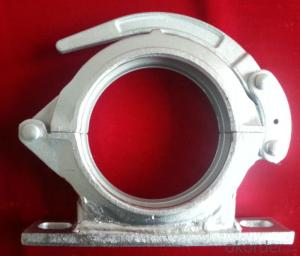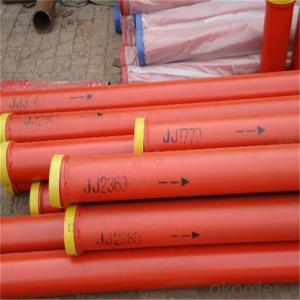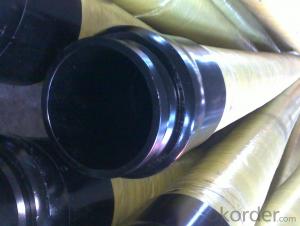Concrete Pump Truck Parts Elbow Bend DN100 R180 90DGR 148MM Mn13-4 Casting
- Loading Port:
- China Main Port
- Payment Terms:
- TT OR LC
- Min Order Qty:
- -
- Supply Capability:
- -
OKorder Service Pledge
Quality Product, Order Online Tracking, Timely Delivery
OKorder Financial Service
Credit Rating, Credit Services, Credit Purchasing
You Might Also Like
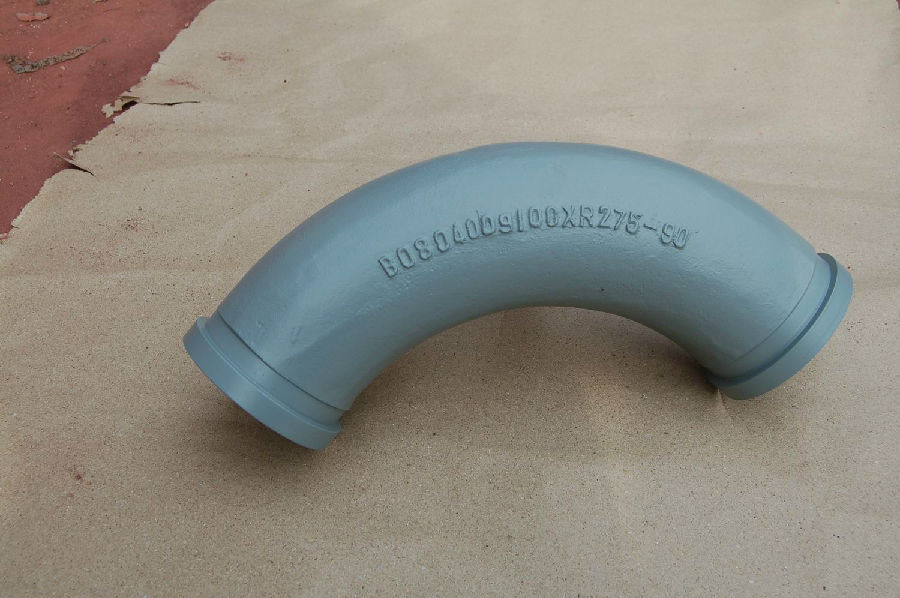
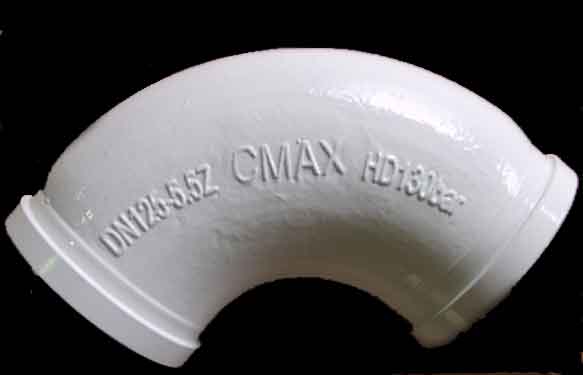
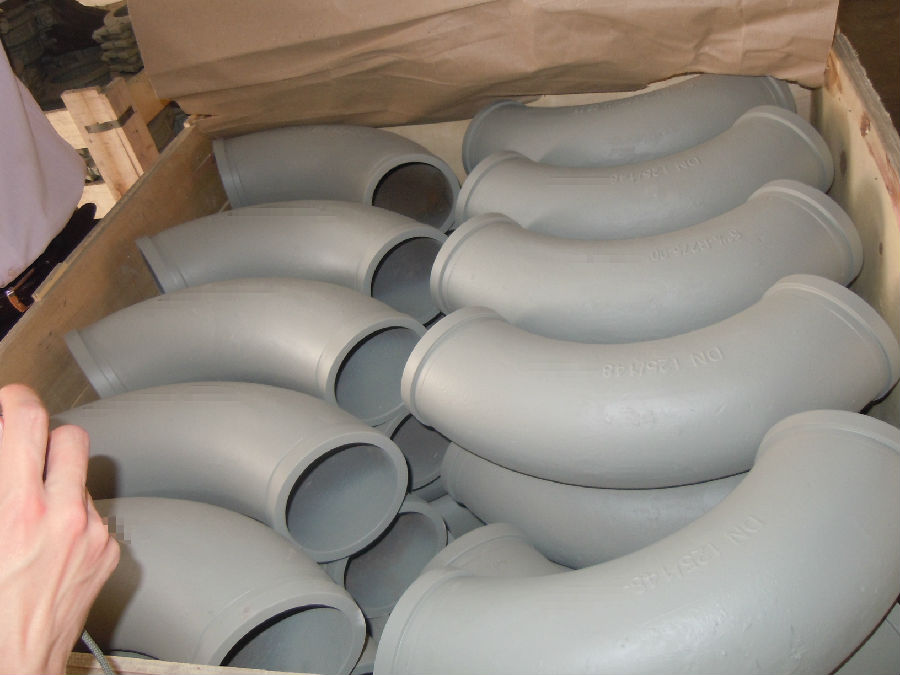
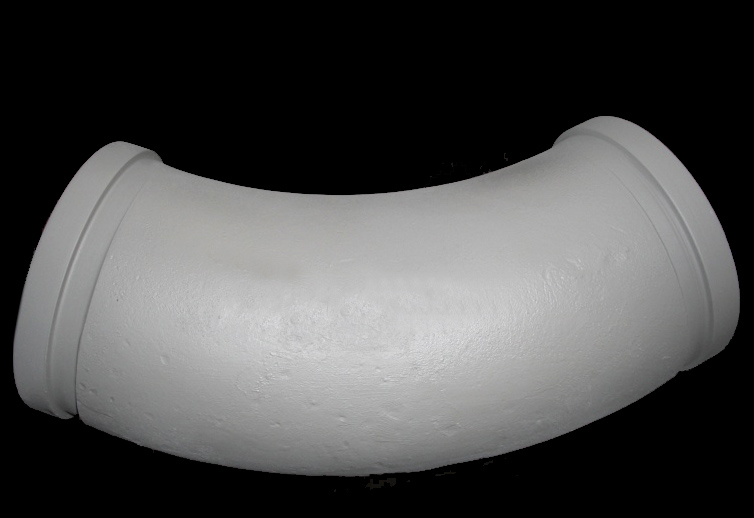
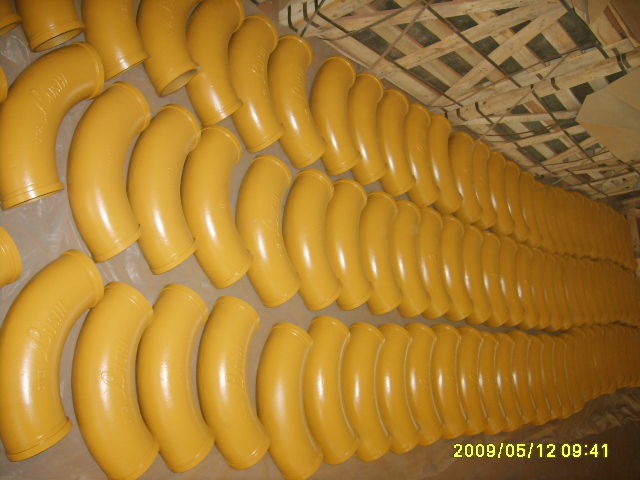
Product Description:
Product Name: Concrete Pump ELBOW DN100
1. Specification of Concrete Pump ELBOW DN100
Dimensions: DN100
Radius: 180mm
Flange: SK, ZX, F&M
Degree: 90
Material: #20 steel, ST52
Thickness: 4.5mm,6mm,7.1mm,7.5mm,10mm,
Working pressure: 180MPa
Notes: total series of concrete pump ELBOW for different brand concrete pump(PUTZMEISTER, SCHWING, CIFA, SANY, ZOOMLION, IHI, KYOKUTO Etc) available from us.
2. Application of Concrete Pump ELBOW DN100
Widely used on concrete pump truck, concrete placing boom, trailer concrete pump etc, for concrete delivery pipe connection.
Our concrete pump bends have been successfully exported to many countries from 1998, Our main markets as below: Middle East, Southeast Asia, America, Brazil, Italy, Russia, South Africa etc
Aiming at the largest concrete pump parts manufacturer, and reliable, professional supplier in China, we can supply concrete pump elbows, delivery pipes, casting or forging couplings, end rubber hoses, rubber pistons, tungsten wear plates, delivery cylinders, and other hydraulic parts, one stop service for your concrete pump parts and accessory business.
3. Package and Delivery of Concrete Pump ELBOW
Every 30pcs put in one seaworthy wooden box, and 20 boxes in one 20feet container.
Product Name: Concrete Pump ELBOW DN100
1. Specification of Concrete Pump ELBOW DN100
Dimensions: DN100
Radius: 180mm
Flange: SK, ZX, F&M
Degree: 90
Material: #20 steel, ST52
Thickness: 4.5mm,6mm,7.1mm,7.5mm,10mm,
Working pressure: 180MPa
Notes: total series of concrete pump ELBOW for different brand concrete pump(PUTZMEISTER, SCHWING, CIFA, SANY, ZOOMLION, IHI, KYOKUTO Etc) available from us.
2. Application of Concrete Pump ELBOW DN100
Widely used on concrete pump truck, concrete placing boom, trailer concrete pump etc, for concrete delivery pipe connection.
Our concrete pump bends have been successfully exported to many countries from 1998, Our main markets as below: Middle East, Southeast Asia, America, Brazil, Italy, Russia, South Africa etc
Aiming at the largest concrete pump parts manufacturer, and reliable, professional supplier in China, we can supply concrete pump elbows, delivery pipes, casting or forging couplings, end rubber hoses, rubber pistons, tungsten wear plates, delivery cylinders, and other hydraulic parts, one stop service for your concrete pump parts and accessory business.
3. Package and Delivery of Concrete Pump ELBOW
Every 30pcs put in one seaworthy wooden box, and 20 boxes in one 20feet container.
- Q: How can one ensure proper functioning of concrete pump spare parts after installation?
- To ensure proper functioning of concrete pump spare parts after installation, it is important to follow a few key steps. Firstly, it is crucial to carefully inspect and clean the parts before installation to ensure they are free from any debris or damage. Additionally, it is essential to use high-quality parts from reputable manufacturers to ensure durability and reliability. Regular maintenance and lubrication of the spare parts is also necessary to prevent wear and tear. Lastly, it is important to operate the concrete pump within its specified limits and avoid overloading, as this can cause stress on the spare parts and lead to malfunctioning.
- Q: How often should I replace concrete pump spare parts?
- The frequency at which you should replace concrete pump spare parts depends on various factors such as the quality of the parts, the intensity of usage, and regular maintenance. Generally, it is recommended to conduct regular inspections and maintenance to identify any signs of wear or damage in the spare parts. As a preventive measure, it is advisable to replace parts that show significant wear or are no longer functioning optimally. However, it is crucial to follow the manufacturer's guidelines and recommendations for the specific concrete pump model you are using. Additionally, consulting with experienced professionals or technicians in the field can provide valuable insights on the expected lifespan of different spare parts and when replacements may be necessary.
- Q: How often should hopper agitator shafts be inspected or replaced in a concrete pump?
- To ensure optimal performance and prevent potential breakdowns, it is important to regularly inspect and maintain the hopper agitator shafts in a concrete pump. The frequency of inspection or replacement depends on factors such as pump usage and operating conditions. As a general rule, it is recommended to inspect the hopper agitator shafts every three to six months. During the inspection, check for signs of wear, damage, or misalignment. If any issues are found, take appropriate measures such as lubricating, realigning, or replacing damaged parts. However, it is crucial to consider the intensity of use, the materials being pumped, and the overall condition of the pump when determining the inspection frequency. For example, if the pump is used heavily or operates continuously, it may be necessary to inspect the agitator shafts on a monthly basis. Regular maintenance and inspection of hopper agitator shafts not only ensure smooth operation but also extend the equipment's lifespan. Detecting and resolving issues in a timely manner can prevent costly repairs or downtime in the future. Additionally, following the manufacturer's maintenance recommendations and guidelines can optimize performance and reliability.
- Q: How do I properly maintain and replace hydraulic filters in concrete pump spare parts?
- Proper maintenance and replacement of hydraulic filters in concrete pump spare parts is crucial to ensure the longevity and efficiency of your equipment. Here are some steps to follow: 1. Understand the manufacturer's recommendations: Start by familiarizing yourself with the manufacturer's guidelines for maintaining and replacing hydraulic filters. These instructions may vary depending on the specific pump model and filter type. 2. Regular inspection: Regularly inspect your hydraulic filters for any signs of damage, clogging, or excessive wear. Look for dirt, debris, or other contaminants that may hinder the filter's performance. If you notice any issues, it is important to address them promptly. 3. Follow a maintenance schedule: Implement a regular maintenance schedule for your hydraulic filters. This schedule should include regular filter inspections, cleaning, and replacement intervals. Adhering to a schedule will help prevent unexpected breakdowns and keep your concrete pump running smoothly. 4. Cleaning the filters: If your hydraulic filters are designed to be cleaned and reused, make sure to follow the proper cleaning procedure. This typically involves removing the filter, washing it with an appropriate cleaning solution, and allowing it to dry thoroughly before reinstallation. Be cautious not to damage the filter during the cleaning process. 5. Replacement: Over time, hydraulic filters will become less effective at filtering out contaminants. It is important to replace them according to the manufacturer's recommended intervals or sooner if they appear excessively dirty or damaged. Always use genuine spare parts to ensure compatibility and optimal performance. 6. Proper installation: When replacing hydraulic filters, ensure that they are installed correctly and securely. Pay attention to any seals or gaskets that may need to be replaced as well. Improper installation can lead to leaks or reduced filtration efficiency. 7. Monitor performance: After replacing the hydraulic filters, monitor the pump's performance closely. Pay attention to any changes in pressure, flow rate, or unusual noises. If you observe any abnormalities, it may indicate a problem with the filter or other components, and further investigation may be necessary. By following these steps, you can properly maintain and replace hydraulic filters in your concrete pump spare parts, ensuring optimal performance and prolonging the lifespan of your equipment.
- Q: How do I properly adjust and control flow rates in concrete pump spare parts?
- To properly adjust and control flow rates in concrete pump spare parts, you should start by examining the pump's manual and understanding its specific settings and controls. It's important to ensure that all valves and levers are in the correct position and functioning properly. Additionally, you can adjust the flow rate by manipulating the stroke length and speed of the pump. Experimenting with these settings while monitoring the flow rate will help you achieve the desired results. Regular maintenance and cleaning of the pump parts are also crucial to ensure smooth flow control.
- Q: What are the different types of concrete pump clamps?
- There are several different types of concrete pump clamps, including snap clamps, bolt clamps, wedge clamps, and quick release clamps. These clamps are used to secure pipes and hoses in place and ensure a tight and secure connection during concrete pumping operations.
- Q: How often should concrete pump clamps be inspected and replaced?
- Concrete pump clamps should be inspected on a regular basis to ensure they are functioning properly and to identify any signs of wear or damage. The frequency of inspections will depend on various factors such as the frequency of use, the type of concrete being pumped, and the working conditions. In general, it is recommended to inspect concrete pump clamps at least once a month or after every 100 hours of operation, whichever comes first. This will help catch any potential issues early on and prevent them from escalating into major problems. Additionally, it is important to visually inspect the clamps before each use to check for any visible signs of damage or wear. This includes checking for cracks, deformations, or any loose or missing bolts. The lifespan of concrete pump clamps will vary depending on the quality of the clamps, the intensity of use, and the maintenance practices. However, as a general guideline, it is recommended to replace the clamps every 1-2 years or sooner if they show significant signs of wear or damage. Regular inspections and timely replacements of concrete pump clamps are vital to ensure the safety and efficiency of the pumping operations. It is always better to be proactive and address any potential issues promptly to prevent costly repairs or accidents.
- Q: What is the function of a concrete pump hydraulic motor?
- The function of a concrete pump hydraulic motor is to provide the necessary power and motion to operate the pumping mechanism of the concrete pump.
- Q: Are there any warranties or guarantees on concrete pump spare parts?
- Yes, there are warranties and guarantees available on concrete pump spare parts. Many reputable manufacturers and suppliers offer warranties to ensure the quality and performance of their products. These warranties typically cover defects in materials or workmanship and provide replacements or repairs within a specified time frame. It is important to check the terms and conditions of the warranty or guarantee provided by the specific supplier or manufacturer before purchasing concrete pump spare parts.
- Q: How do I properly maintain and replace wear plates in concrete pump spare parts?
- Achieving optimal performance and durability for your equipment relies heavily on the proper maintenance and replacement of wear plates in concrete pump spare parts. To ensure that your wear plates are adequately maintained and replaced, the following steps can be taken: 1. Conduct regular inspections: It is crucial to regularly inspect the wear plates in your concrete pump spare parts in order to identify any signs of wear or damage. Look for visible indications such as cracks, excessive wear, or deterioration. 2. Thoroughly clean the area: Prior to replacing the wear plates, it is essential to thoroughly clean the surrounding area. Remove any debris, dirt, or hardened concrete that may be present. Utilize a pressure washer or wire brush to effectively clean the surface. 3. Measure the thickness of wear plates: Utilize a precision measuring tool to determine the thickness of the wear plates. Compare the current thickness with the manufacturer's recommended specifications to determine if replacement is necessary. If the wear plates are below the recommended thickness, replacement is required. 4. Remove the old wear plates: Carefully remove the old wear plates using the appropriate tools. Take note of their positions and any alignment marks to ensure proper installation of the new plates. 5. Prepare the new wear plates: Prior to installing the new wear plates, verify that they are the correct size and meet the required specifications for your concrete pump. Inspect the new plates for any defects or damage before proceeding. 6. Apply lubrication: Apply a thin layer of lubricant or anti-seize compound to the mating surface of the new wear plates. This will aid in preventing corrosion and facilitate future replacements. 7. Install the new wear plates: Position the new wear plates accurately, aligning them with any reference marks or indicators. Secure them tightly using suitable bolts or fasteners, taking care not to overtighten. 8. Test and check alignment: After installing the new wear plates, perform a test run of the concrete pump to ensure proper functionality. Check for any leaks, uncommon vibrations, or misalignments. If any issues are detected, address them promptly. 9. Establish a regular maintenance schedule: To prevent premature wear and damage to the wear plates, create a routine maintenance schedule. This may involve cleaning, lubricating, and inspecting the wear plates at specified intervals or after a certain number of operational hours. By adhering to these steps and adopting a proactive approach to wear plate maintenance and replacement, you can guarantee the seamless operation and extended lifespan of your concrete pump spare parts.
Send your message to us
Concrete Pump Truck Parts Elbow Bend DN100 R180 90DGR 148MM Mn13-4 Casting
- Loading Port:
- China Main Port
- Payment Terms:
- TT OR LC
- Min Order Qty:
- -
- Supply Capability:
- -
OKorder Service Pledge
Quality Product, Order Online Tracking, Timely Delivery
OKorder Financial Service
Credit Rating, Credit Services, Credit Purchasing
Similar products
Hot products
Hot Searches
Related keywords
